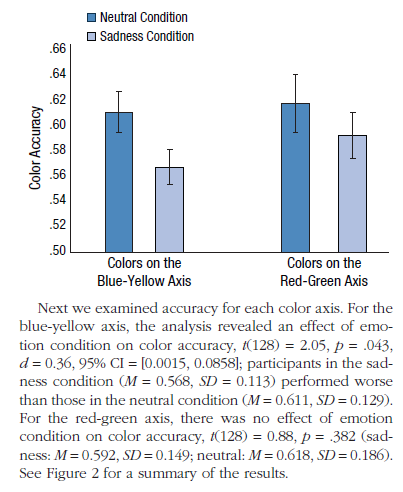The proximal offender here is Sarah Berry, "Life and Style Reporter", who pre-digests this piffle for the Sydney Morning Herald,¹ and one can only hope that she is aware what her career has become. Her space-wasting vapidity has international appeal -- a gap to be filled between advertisements is the same size everywhere in the world -- and evidently it is cheaper than the alternatives, so our own Dom-Post [Wellington's Paper of Note] syndicates her columns.
The distal culprit is Psychological Science, which I remember reading back when it was still funny
</hipster>.The claim here is that Sadness impairs the capacity to see Blue... or rather, to see differences along the Yellow-Blue dimension of the colour plane, relative to the Red-Green dimension.
 It rests on a task where emotion-provoking distractions degraded performance along both dimensions. The Blue-Yellow degradation reached the threshold of statistical significance, the Red-Green degradation did not... but this is not dispositive evidence that the dimensional difference itself is significant.
It rests on a task where emotion-provoking distractions degraded performance along both dimensions. The Blue-Yellow degradation reached the threshold of statistical significance, the Red-Green degradation did not... but this is not dispositive evidence that the dimensional difference itself is significant.Great was the anger of post-publication reviewers (reducing their ability to see small colour differences along the Red-Green dimension (or perhaps it was jealousy)), and they piled on to point out this statistical Fail (a flaw that the authors might have noticed, were they not too busy describing how utterly surprised they were by the results)... so enjoy the paper now before it is retracted
Meanwhile at the Riddled Research Laboratory, could we get funding to study the effects of Terror-inducing stimuli, and whether they impair the capacity to see strange colours that could not be put into any words, colour which was almost impossible to describe? COULD WE BOGROLL.
Leader of the research team was Andrew Elliot, who has made a career of this sort of thing, upholstering an impressive CV with no end of sexy-topic colour-psychology science-fair projects on "Green Facilitates Creative Performance" and "Women's use of red clothing as sexual signal in intersexual interaction" and "The effect of red on performance attainment", the results in each case taking him and his grad-student researchers by utter surprise.² Elliot understands the kind of material that churnalists like to have handed to them, and the need of the wider audience to read pre-digested confirmations of their inchoate magical-thinking notions of how the world operates.
Given the prevalence of color, one would expect color psychology to be a well-developed area. Surprisingly, little theoretical or empirical work has been conducted to date on the influence of color on psychological functioning, and the work that has been done has been driven mostly by practical concerns, not scientific rigor.Andrew Elliot's honours include his Editorial position at Psychological Science.
----------------------------------------------------------------------
1 Hazmat suits are advised before reading the SMH article, for it links all too quickly to chromatherapy credulity:
Colours have been used as therapy in Eastern cultures
and to more Elliot-themed PopSci puffle.2 Also too:
Romantic Red: Red Enhances Men’s Attraction to Women
Anger as Seeing Red: Perceptual Sources of Evidence
Bored now.
----------------------------------------------------------------------
UPDATED with bonus colour-themed evol-psych:This study received more muted and almost factual descriptions in the press;³ the authors are less adept at writing their press releases to fit into the flerovium-289 attention span of the targeted churnalists.
rather than conveying a certain testosterone-fuelled fortitude, red clothing sends out a signal that the wearer is angry, aggressive and prone to dominant behaviour.See, my apoplectic complexion is evidence of my manly dominance, not of excessive use of akvavit.
Researchers at Durham University found that when male and female volunteers were shown images of men in a series of differently coloured T-shirts, both sexes associated those dressed in scarlet with aggression – in the same way as if their face had reddened.
In what may be an echo of the way certain male animals use displays of red to warn off competitors when mating, men (but not women) also associated other men wearing red with dominance.
The correlation is supposed to be evolutionary and universal, but it evidently does not hold true in the Federation.
Thanks Galina!
----------------------------------------------------------------------
3 With a few honourable exceptions, e.g. the Daily Torygraph:British "redcoats" may have been helped to victory in the Battle of Waterloo by the colour of their uniforms, new research suggests.
Men wearing red are seen as more aggressive, angry and dominant than those dressed in blue or grey, a study has shown.
So Napoleon's blue-clad troops would have been at a distinct psychological disadvantage when they confronted the Duke of Wellington's forces in 1815.





7 comments:
the results in each case taking him and his grad-student researchers by utter surprise.*
"We never imagined as we ran regressions on every possible combination of variables that one of them might lead to a publishable paper." Also known as, what, you're supposed to have a hypothesis before you test it?
you're supposed to have a hypothesis before you test it?
Too. Much. Work.
~
Conceivably the astonishment alleged in the press release is disingenuous --
"We were surprised by how specific the effect was, that color was only impaired along the blue-yellow axis,” says Thorstenson. “We did not predict this specific finding"
-- conceivably each study started out with a specific colour effect and then the data were tortured until they confessed.
Ah - the tyranny of p<0.05. It's all plot.
Well see here, S.C. It seems to me (albeit, and untrained layman) that you started with a blog post and then went in search of a title.
~
I wish someone would prove the null hypothesis. Save a lot of work.
you started with a blog post and then went in search of a title
And I was utterly astonished when I found one!
Post a Comment